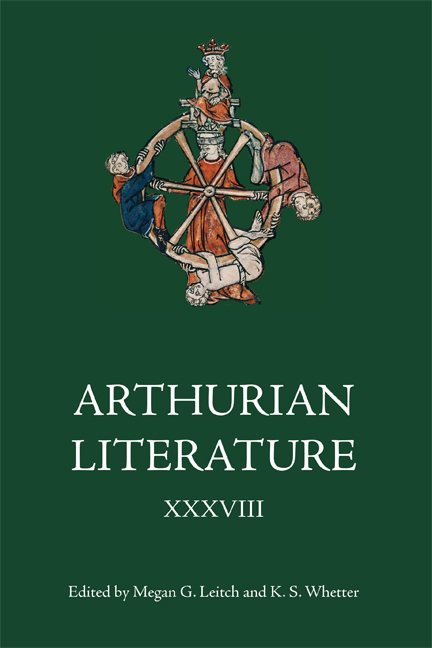Book contents
- Frontmatter
- Contents
- List of Figures and Tables
- Note on the Derek Brewer Prize
- General Editors’ Preface
- List of Contributors
- List of Abbreviations
- 1 The Inaugural Derek Brewer Essay Prize: Animals at the Feast: Strange Strangers and Courtly Power in The Wedding of Sir Gawain and Dame Ragnelle
- 2 The Kindred of a Boy without a Father: Merlin’s British Forebears and Irish Cousins
- 3 Geoffrey of Monmouth’s Subtle Subversion: Active Double- Voiced Discourse in the Historia regum Britanniae
- 4 ‘Cornwall, up in the North’: Geography and Place Names in the Source of the Old Icelandic Brut
- 5 Enacting Arthurianism in the Order of the Garter and Sir Gawain and the Green Knight
- 6 Deviants and Dissenters: Theorizing Shame and Punishment in Malory’s Morte
- 7 Loyalty and Worshyp in Conflict in Malory’s Lancelot
- 8 Emotional Inheritance in Malory’s Morte Darthur: Shame and the Lott–Pellinore Feud
- 9 Navigating and Indexing Arthurian Romance in Benoît Rigaud’s Edition of Lancelot du Lake (1591)
- 10 ‘A great many strange puppets’: Queen Caroline, Merlin’s Cave, and Symbolic Arthurianism in the Age of Reason
- 11 How Galahad Regained his Virginity: Dead Women, Catholicism and the Grail in Nineteenth-Century British Poetry
- Notes
- Miscellaneous Endmatter
9 - Navigating and Indexing Arthurian Romance in Benoît Rigaud’s Edition of Lancelot du Lake (1591)
Published online by Cambridge University Press: 10 January 2024
- Frontmatter
- Contents
- List of Figures and Tables
- Note on the Derek Brewer Prize
- General Editors’ Preface
- List of Contributors
- List of Abbreviations
- 1 The Inaugural Derek Brewer Essay Prize: Animals at the Feast: Strange Strangers and Courtly Power in The Wedding of Sir Gawain and Dame Ragnelle
- 2 The Kindred of a Boy without a Father: Merlin’s British Forebears and Irish Cousins
- 3 Geoffrey of Monmouth’s Subtle Subversion: Active Double- Voiced Discourse in the Historia regum Britanniae
- 4 ‘Cornwall, up in the North’: Geography and Place Names in the Source of the Old Icelandic Brut
- 5 Enacting Arthurianism in the Order of the Garter and Sir Gawain and the Green Knight
- 6 Deviants and Dissenters: Theorizing Shame and Punishment in Malory’s Morte
- 7 Loyalty and Worshyp in Conflict in Malory’s Lancelot
- 8 Emotional Inheritance in Malory’s Morte Darthur: Shame and the Lott–Pellinore Feud
- 9 Navigating and Indexing Arthurian Romance in Benoît Rigaud’s Edition of Lancelot du Lake (1591)
- 10 ‘A great many strange puppets’: Queen Caroline, Merlin’s Cave, and Symbolic Arthurianism in the Age of Reason
- 11 How Galahad Regained his Virginity: Dead Women, Catholicism and the Grail in Nineteenth-Century British Poetry
- Notes
- Miscellaneous Endmatter
Summary
The study of paratexts in medieval and early-modern books in manuscript and print is far from a recent phenomenon in scholarship. But it is fair to say that the materiality of the book as an object of study is currently surfing a rising swell of popularity amongst both literary scholars and historians, who see it as a tangible means by which to trace and track matters of reception and readerly taste, thus allowing them to take their study beyond the mere evaluation of the content and form of the text itself. Gérard Genette famously coined the term ‘paratext’ to describe extra-textual matter that forms a type of threshold (seuil, in the original French) through which readers can step in order to experience a deeper understanding of the text proper. Scholars, he argues, can follow in their footsteps and cross these thresholds so as to gain a greater understanding of the nature of these previous readers’ engagement with the text. There is not sufficient space here to do justice to the many different facets of paratextual and materiality studies of the sort that have arisen in the wake of Genette's seminal work, which pertains as much to modern textual studies as it does to pre-modern, but some of the key areas of fascination can be summarised as follows: marginalia added by readers as keys to nuancing our understanding of reception (as well as more mundane matters such as ownership); prefaces and prologues as indexes of rewriting and motivation for publication; illustration and word/image connections as clues to the target reader's understanding and comprehension of the text, as well as to that reader's likely cultural knowledge; developing practices of book layout and finding-aid provision as insights into both historical reading practice and reading skills development, as well as changing use of, and even taste for, particular texts. The list could, of course, go on, but it is in this last area, layout and finding-aid provision, that this article finds its locus.
The study of the history of the book in this context might most profitably be seen as tracing and understanding the development of a particular technology, the book itself being that technology. Like all technology, it undergoes regular updates so as to remain operational to users as their own needs change and develop.
- Type
- Chapter
- Information
- Arthurian Literature XXXVIII , pp. 236 - 253Publisher: Boydell & BrewerPrint publication year: 2023



